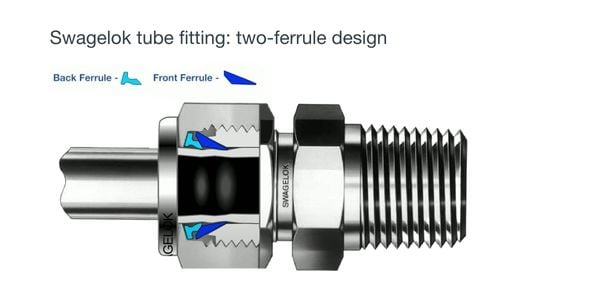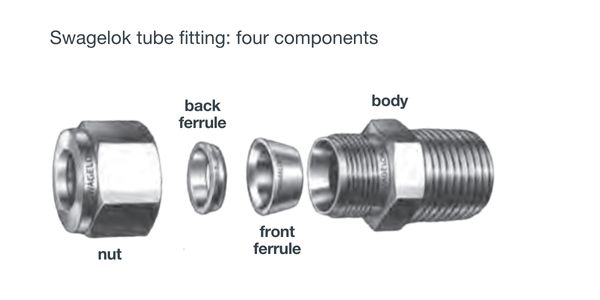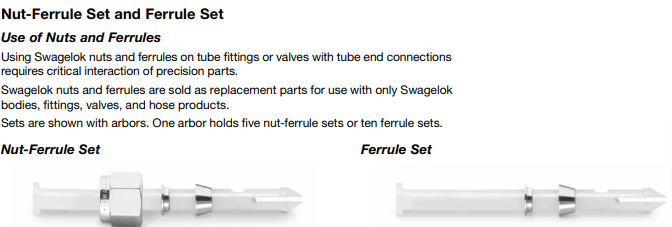Share this
Refurbishing & Re-Using Swagelok Tube Fittings (Photos, Video, PDF)
by Katie Reid on Wed, Jan 25, 2023 @ 08:01 AM
If you are taking a system apart for maintenance or repair, and putting it back together in exactly the same way, can you use the original fittings and ferrules? Probably yes. In this article we provide pointers on where it may make sense in your system to re-use and refurbish.
Some customers may worry about re-using parts, especially if they have been using other brands. That is understandable. But when properly installed, Swagelok fittings produce a repeatable, leak-tight seal even after being reassembled multiple times. (To get a hand with evaluating Swagelok fittings for reuse, consider using our Fitting Reclamation Program.)
Swagelok developed the original two-ferrule tube fitting in 1947. The two-ferrule design enables leak-tight performance with a robust tube grip and vibration resistance. Its dependability has been documented in numerous published test reports, including those performed under extreme conditions.
 Two-ferrule mechanical grip design
Two-ferrule mechanical grip design
The Swagelok tube fitting is a flareless mechanical-grip type fitting. This type of fitting design has a body, a nut, a front ferrule, and a back ferrule. The two ferrules separate sealing and tube-retaining functions, with each optimized for its job. Here are the four components:
 Each ferrule is optimized for its job
Each ferrule is optimized for its job
One advantage of the two-ferrule fitting design is the ability to reuse the body without leaks. Most of the cost of replacement is in the fittings, not the nuts and ferrules. Sometimes you don't even have to replace the ferrules.
If you have made changes in the system design, by moving a fitting to a new location or changing the tubing, you can't re-use the nuts and ferrules, but you can still re-use the fitting bodies. Even on a simple connector, you are saving a big percentage of the cost of using all-new parts. Think of a cross or a tee that is more robust - there is a huge cost savings opportunity there.
Before disassembly, mark a line along the nut and body flat and use these marks to ensure that the fitting is reinstalled properly. Please watch the video demonstration below for the proper instructions:
In this step-by-step video, we show the most effective way to reassemble tube fittings while maintaining a leak-tight seal
This video includes detailed illustrations of a Swagelok tube fitting's parts.
Technical detail on replacement parts is available in the Swagelok Gaugeable Tube Fittings and Adapter Fittings catalogue. You are also welcome to shop "Ferrule Sets - Replacement Parts & Accessories" at swagelok.com.

As mentioned above, if you are in doubt, consider taking advantage of our Fitting Reclamation Program. Working together, we'll show you where it makes sense in your system to re-use and refurbish. Just click below and answer a few questions. A senior member of our team will follow up within one business day. There is no obligation created. We are here to help.
Share this
- Fittings (82)
- Cost Savings (70)
- Valves (67)
- Fabrication (59)
- Services (41)
- Videos (33)
- Steam Systems (29)
- Training (27)
- Downloads (25)
- Resources (25)
- Sampling (24)
- Tubing (24)
- Field Advisors (18)
- Hoses (12)
- Oil & Gas (10)
- Regulators (9)
- Winterization (9)
- Gas Distribution (7)
- Hydrogen & Clean Energy (4)
- About Us (2)
- Measurement (2)
- February 2025 (1)
- November 2024 (1)
- October 2024 (2)
- August 2024 (1)
- July 2024 (1)
- June 2024 (4)
- April 2024 (4)
- March 2024 (2)
- January 2024 (3)
- December 2023 (2)
- November 2023 (3)
- October 2023 (2)
- September 2023 (3)
- August 2023 (3)
- July 2023 (3)
- June 2023 (2)
- May 2023 (4)
- April 2023 (2)
- March 2023 (2)
- February 2023 (3)
- January 2023 (2)
- December 2022 (1)
- November 2022 (1)
- October 2022 (2)
- September 2022 (5)
- August 2022 (3)
- July 2022 (6)
- June 2022 (4)
- May 2022 (3)
- April 2022 (1)
- March 2022 (2)
- February 2022 (3)
- January 2022 (4)
- December 2021 (4)
- November 2021 (6)
- October 2021 (3)
- September 2021 (5)
- August 2021 (9)
- July 2021 (5)
- June 2021 (7)
- May 2021 (7)
- April 2021 (4)
- March 2021 (3)
- February 2021 (3)
- January 2021 (2)
- December 2020 (3)
- November 2020 (3)
- October 2020 (2)
- September 2020 (3)
- August 2020 (3)
- July 2020 (3)
- June 2020 (3)
- May 2020 (3)
- April 2020 (2)
- March 2020 (3)
- February 2020 (3)
- January 2020 (3)
- December 2019 (2)
- November 2019 (3)
- October 2019 (3)
- September 2019 (2)
- August 2019 (3)
- July 2019 (2)
- June 2019 (2)
- May 2019 (3)
- April 2019 (3)
- March 2019 (3)
- February 2019 (2)
- January 2019 (3)
- December 2018 (2)
- November 2018 (2)
- October 2018 (4)
- September 2018 (2)
- August 2018 (3)
- July 2018 (3)
- June 2018 (2)
- May 2018 (4)
- April 2018 (3)
- March 2018 (3)
- February 2018 (3)
- January 2018 (4)
- December 2017 (1)
- November 2017 (4)
- October 2017 (4)
- September 2017 (4)
- August 2017 (5)
- July 2017 (3)
- June 2017 (4)
- May 2017 (4)
- April 2017 (3)
- March 2017 (5)
- February 2017 (4)
- January 2017 (4)
- December 2016 (3)
- November 2016 (3)
- October 2016 (4)
- September 2016 (3)
- August 2016 (4)
- July 2016 (2)
- June 2016 (2)
- May 2016 (2)
- April 2016 (4)
- March 2016 (2)
- February 2016 (3)
- January 2016 (4)
- December 2015 (4)
- November 2015 (4)
- October 2015 (5)
- September 2015 (2)
- August 2015 (4)
- July 2015 (5)
- June 2015 (2)
- May 2015 (3)
- April 2015 (5)
- March 2015 (3)
- February 2015 (4)
- January 2015 (3)
- December 2014 (5)
- November 2014 (4)
- October 2014 (4)
- September 2014 (4)
- August 2014 (4)
- July 2014 (5)
- June 2014 (4)
- May 2014 (4)
- April 2014 (5)
- March 2014 (4)
- February 2014 (4)
- January 2014 (4)
- December 2013 (3)
- November 2013 (4)
- October 2013 (5)
- September 2013 (4)
- August 2013 (5)
- July 2013 (4)
- June 2013 (3)
- May 2013 (4)
- April 2013 (5)
- March 2013 (2)
- February 2013 (3)
- January 2013 (5)
- December 2012 (3)
- November 2012 (3)
- October 2012 (5)
- September 2012 (3)
- August 2012 (4)
- July 2012 (4)
- June 2012 (1)



